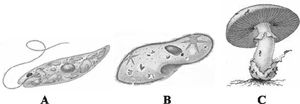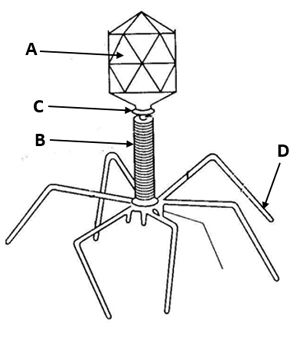Choose the correct names of the different bacteria given below according to their shapes.

A – Cocci, B – Bacilli, C – Spirilla, D – Vibrio
A – Bacilli, B – Cocci, C – Spirilla, D – Vibrio
A – Spirilla, B – Bacilli, C – Cocci, D – Vibrio
A – Spirilla, B – Vibrio, C – Cocci, D – Bacilli
Correct Answer :
A. A – Cocci, B – Bacilli, C – Spirilla, D – Vibrio
A - Cocci (spherical), B - Bacilli (rod shaped), C - Spirilla (spiral), D - Vibrio (comma shaped). These are all the shapes of the bacteria.
Related Questions
Which one of the following is a characteristic feature of chrysophytes?
They are parasitic forms which cause diseases in animals.
They have a protein rich layer called pellicle.
They have indestructible wall layer deposited with silica.
They are commonly called dinoflagellates.
Which of the following statements regarding cyanobacteria is incorrect?
It is also called blue green algae.
They are chemosynthetic autotrophs.
It forms blooms in polluted water bodies.
It is unicellular, colonial or filamentous, marine or terrestrial bacteria.
The subunit of capsid is called
core
nucleotide
amino acid
capsomere
Which of the following group of kingdom protista is being described by the statements given below ?
(i) This group includes diatoms and golden algae.
(ii) They are microscopic and float passively in water currents (plankton).
(iii) Most of them are photosynthetic.
(iv) They have deposits in their habitat; this accumulation over billion of years is referred to as diatomaceous earth.
Dinoflagellates
Chrysophytes
Euglenoids
Slime moulds
Match column-I (Characters/feature) with column-II (examples) and choose the correct option.
| Column-I | Column-II |
|---|---|
| (Characters/features) | (Examples) |
| A. Red dinoflagellates | I. Rhizopus |
| B. Unicellular fungi used to | II. Gonyaulax make bread and beer |
| C. Source of antibiotics | III. Yeast |
| D. Bread mould | IV. Penicillium |
A III; B II; C I; D IV
A II; B III; C I; D IV
A II; B III; C IV; D I
A II; B IV; C III; D I
Match the scientists given in column I with their discovery given in column II and choose the correct option.
| Column-I | Column-II |
|---|---|
| (Scientists) | (Discovery) |
| A. Ernst Mayr | I. Discovered Viroids |
| B. Whittaker | II. Gave the name virus |
| C. Pasteur | III. Proposed five kingdom classification |
| D. Diener | IV. Darwin of the 20th century |
A IV, B III, C II, D I
A III, B IV, C II, D I
A II, B III, C IV, D I
A I, B II, C III, D IV
Which of the following is smallest living cell and can live without oxygen ?
Mycoplasma
Mycorrhiza
Euglena
Trypanosoma
Match column I (Kingdom) with column II (Class) and select the correct options
| Column-I | Column-II |
|---|---|
| (Kingdom) | (Class) |
| A. Plantae | I. Archaebacteria |
| B. Fungi | II. Euglenoids |
| C. Protista | III. Phycomycetes |
| D. Monera | IV. Algae |
A IV, B III, C II, D I
A I, B II, C III, D IV
A III, B IV, C II, D I
A IV, B II, C III, D I
Choose the correct names of the different bacteria given below according to their shapes.

A – Cocci, B – Bacilli, C – Spirilla, D – Vibrio
A – Bacilli, B – Cocci, C – Spirilla, D – Vibrio
A – Spirilla, B – Bacilli, C – Cocci, D – Vibrio
A – Spirilla, B – Vibrio, C – Cocci, D – Bacilli
Identify the following figures A, B and C.

A – Euglena, B – Paramecium, C – Agaricus
A – Euglena, B – Planaria, C – Agaricus
A – Planaria, B – Paramecium, C – Agaricus
A – Euglena, B – Paramecium, C – Aspergillus
Which of the following statement is not correct for methanogens?
They are archaebacteria.
They live in marshy areas.
Methane is their preferred carbon source.
They are present in guts of several ruminant animals (cow, buffaloes) and produce biogas (CH4) from the dung of these animals.
Which of the following statement is correct for both bluegreen algae and bacteria ?
Both show anaerobic respiration.
Both have chlorophyll pigment.
Both are devoid of true nucleus.
None of the above
T. O. Diener discovered a new infectious agent that was smaller than viruses and have the following characteristics.
(i) It causes potato spindle tuber disease.
(ii) It has free RNA.
(iii) Molecular weight of RNA is low.
Identify the infections agent.
Viruses
Viroids
Virion
Mycoplasma
The given statements are some characters of a particular group of Kingdom protista.
(i) Most of them are fresh water organisms found in standing water.
(ii) They have a protein rich layer (called pellicle) which makes their body flexible.
(iii) They have two flagella, a short and a long one.
(iv) Though they are photosynthetic in the presence of sunlight, but in the absence of sunlight they behave like heterotrophs by predating on other smaller organisms.
Identify the correct group on the basis of these characters.
Protozoans
Chrysophytes
Slime moulds
Euglenoids
The figure given below shows the structure of a bacteriophage. Identify its parts labelled as A, B, C and D.

A - Tail fibres B - Head C - Sheath D - Collar
A - Sheath B - Collar C - Head D - Tail fibres
A - Head B - Sheath C - Collar D - Tail fibres
A - Collar B - Tail fibres C - Head D - Sheath
How many bacteria are produced in four hours if a bacterium divides once in half an hour ?
8
64
16
256
Refer the given figure of bacteria cell and Nostoc and choose the option which shows correct label for the structure marked as A, B, C, D and E ?

A – Cell wall, B – Cell membrane, C – Heterocyst, D – DNA, E – Mucilagenous sheath
A – Cell wall, B – Cell membrane, C – DNA, D – Heterocyst, E – Mucilagenous sheath
A – Mucilagenous sheath, B – Cell membrane, C – DNA, D – Heterocyst, E – Cell wall
A – Cell membrane, B – Cell wall, C – DNA, D – Heterocyst, E – Mucilagenous sheath
Which of the following class of fungi is being described by the given statements ?
(i) They are found in aquatic habitats and on decaying wood in moist and damp places.
(ii) Mycelium is aseptate and coenocytic.
(iii) Asexual reproduction takes place by zoospores (motile) or by aplanospores (non-motile).
(iv) Some common examples are Mucor, Rhizopus and Albugo.
Ascomycetes
Phycomycetes
Basidiomycetes
Deuteromycetes
Which one of the following statement is correct for archaea?
Archaea resemble eukaryotes in all respects.
Archaea have some novel features that are absent in other prokaryotes and eukaryotes.
Archaea completely differ from both prokaryotes and eukaryotes.
Archaea completely differ from prokaryotes.
Assume that two normal hyphal cells of different fungal mating types unite. After a period of time, the cell between these cells will dissolve producing a
mycelium
fruiting body
zygote
dikaryotic cell, which is also heterokaryotic
Which group of fungi is commonly known as imperfect fungi ?
Phycomycetes
Ascomycetes
Basidiomycetes
Deuteromycetes
Which of the following pigment is present in cyanobacteria?
Chlorophyll a
Chlorophyll b
Chlorophyll c
Chlorophyll d
Match the type of protozoans given in column-I with their examples given in column-II and choose the correct option.
| Column-I | Column-II |
|---|---|
| (Type of Protozoans) | (Examples) |
| A. Amoeboid protozoans | I. Paramecium |
| B. Ciliated protozoans | II. Plasmodium |
| C. Flagellated protozoans | III. Amoeba |
| D. Sporozoans | IV. Trypanosoma |
A I; B III; C IV; D II
A III; B I; C II; D IV
A III; B I; C IV; D II
A III; B IV; C I; D II
Fungi are filamentous with the exception of X which is unicellular. Identify X.
Yeast
Algae
Bacteria
Lichen
Yeast is not included in protozoans but in fungi because
it has no chlorophyll.
some fungal hyphae grow in such a way that they give the appearance of pseudomycelium.
it has eukaryotic organization.
cell wall is made up of cellulose and reserve food material is starch.
Which of the following is a parasitic fungi on the mustard plant ?
Albugo
Puccinia
Yeast
Ustilago
The most abundant prokaryotes helpful to humans in making curd from milk and in production of antibiotics are the ones categorised as
cyanobacteria
archaebacteria
chemosynthetic autotrophs
heterotrophic bacteria
Match the characters given in column I with their examples given in column II.
| Column I | Column II |
|---|---|
| A. Long slender thread | (i) Lichen like structures |
| B. Association of fungi with | (ii) Mycorrhiza roots of higher plants |
| C. Parasitic fungi on mustard | (iii) Neurospora |
| D. Fungi extensively used in | (iv) Albugo biochemical and genetic work |
| E. An association in which | (v) Hyphae algal component is called phycobiont |
A-(v) B-(ii) C-(iv) D-(iii) E-(i)
A-(iii) B-(i) C-(iv) D-(ii) E-(v)
A-(ii) B-(i) C-(iii) D-(v) E-(iv)
A-(iii) B-(ii) C-(iv) D-(i) E-(v)
Mycorrhizae are useful for plants because they
fix atmospheric nitrogen.
enhance absorption of nutrients from the soil.
kill insects and pathogen.
provide resistance against abiotic stresses.
Which of the following statement(s) is/are correct about ascomycetes ?
(i) Neurospora, which is used in biochemical and genetic work is a member of this class.
(ii) They are mostly multicellular, e.g., Yeast, or rarely unicellular, e.g., Penicillium.
(iii) They are saprophytic, decomposers, parasitic or coprophilous.
(iv) Some examples are Aspergillus, Claviceps and Neurospora.
Both (i) and (ii)
Only (ii)
(i), (iii) and (iv)
All of these
